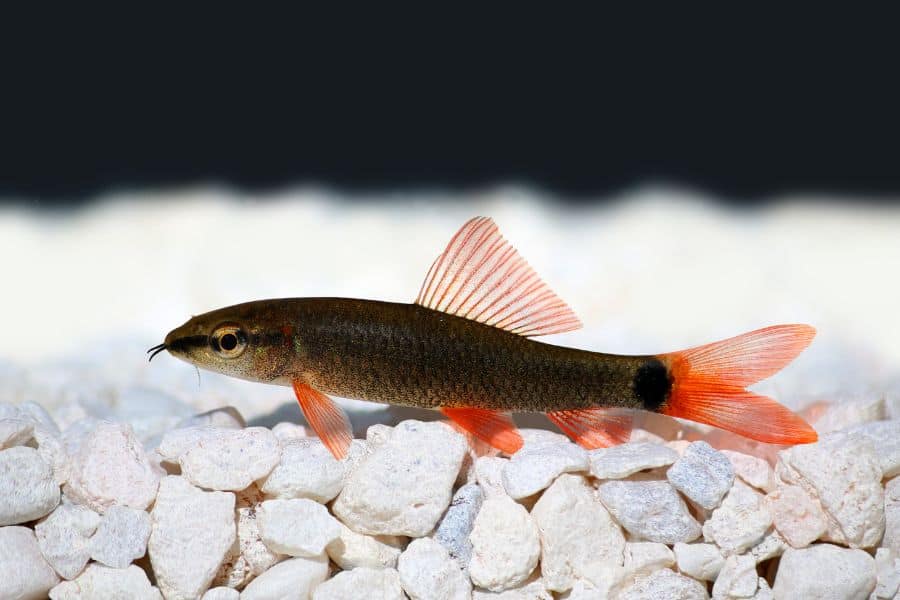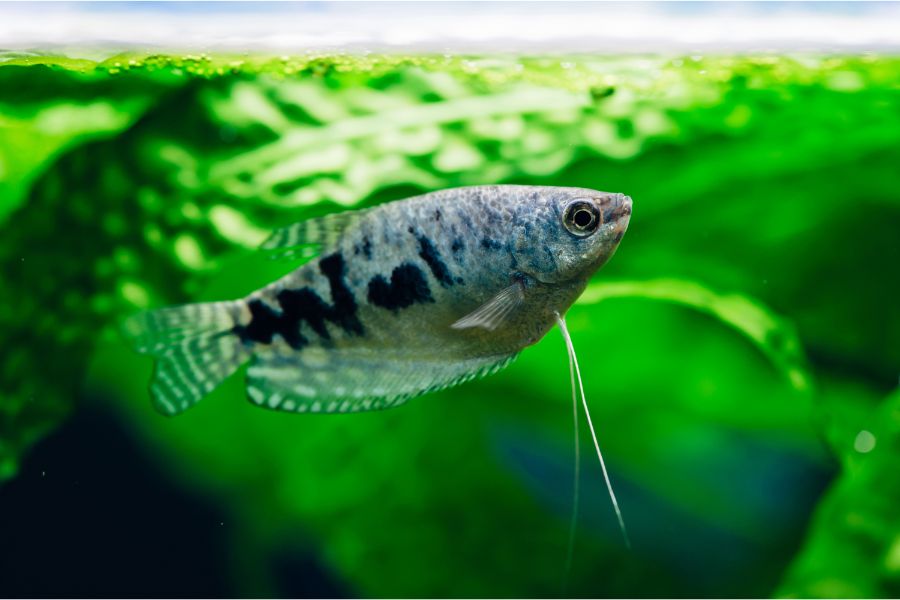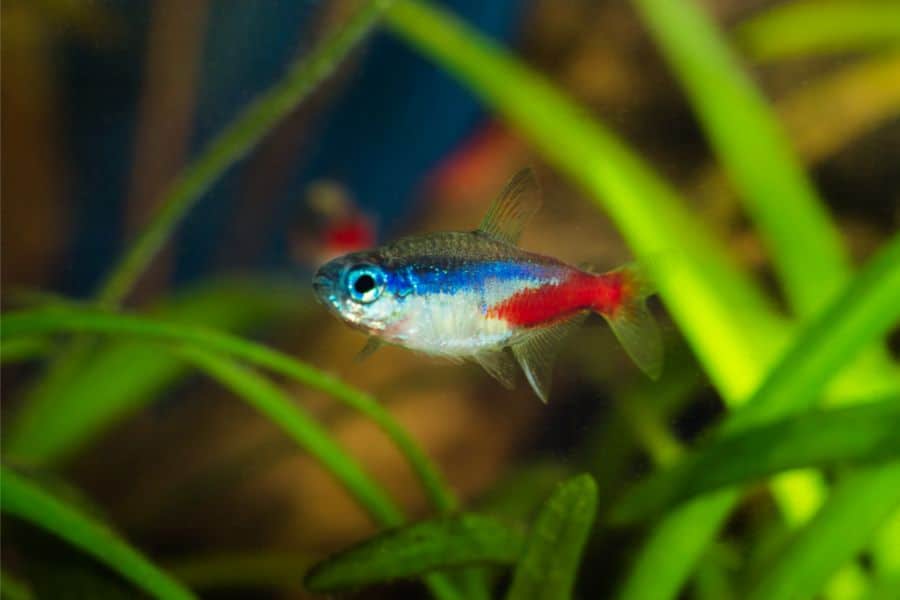Rainbow sharks are beautiful and entertaining fish that has grown in popularity among aquarium lovers. Rainbow sharks are a fascinating addition to any household tank due to their stunning appearance and distinctive temperament.
However, owning and caring for these fish involves a degree of understanding and responsibility. This article will cover everything about rainbow sharks from their appearance, average lifespan, tank requirements, water quality, tank mates, breeding, and nutrition.
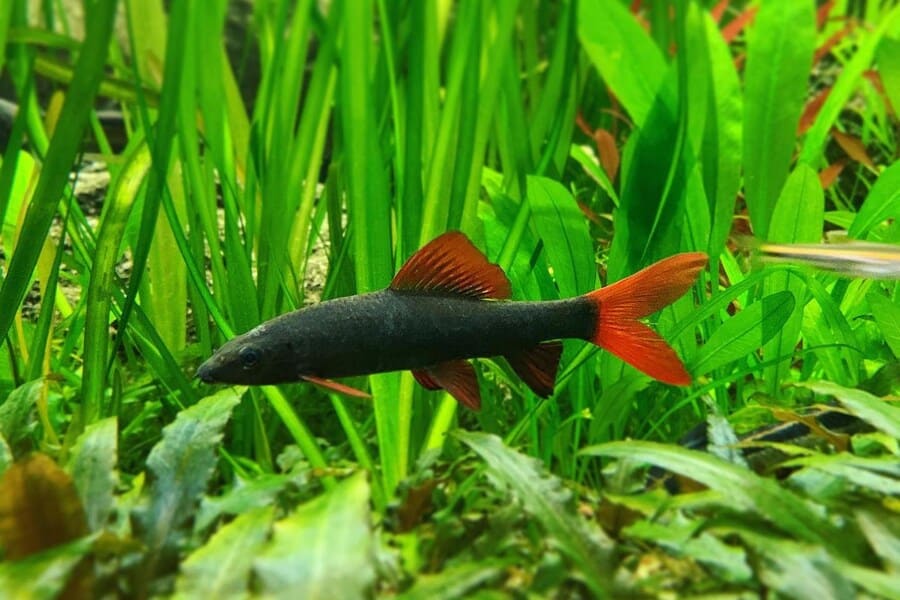
We will also cover common health issues and how to address them, as well as compatibility with other fish.
By the end of this article, you will have a comprehensive understanding of these magnificent fish and be equipped with the knowledge necessary to care for them responsibly.
Rainbow Shark Overview
| Scientific Name | Epalzeorhynchos frenatum |
| Size | 6 inches (15 cm) |
| Life Expectancy | 4-6 years |
| Temperament | Can be aggressive towards other fish, especially other bottom-dwellers |
| Diet | Omnivorous; will eat flakes, pellets, frozen and live foods |
| Tank Size | Minimum of 55 gallons for one Rainbow shark |
| Tank Temperature | 24-27°C |
| Water Hardness | 5-11 dGH |
| Water pH | 6.5-7.5 |
Red-fin sharks, commonly referred to as rainbow sharks, are a well-known type of freshwater fish that are found in Southeast Asian rivers and streams. Rainbow sharks are scientifically known as Epalzeorhynchos frenatum and are members of the Cyprinidae family.
Rainbow sharks live in a range of aquatic settings, including tiny streams, rivers, and rice fields in the wild. They are indigenous to territories in the Mekong River region, especially Malaysia, Thailand, and Indonesia.
Unfortunately, the popularity of Rainbow sharks in the aquarium trade has resulted in overfishing and environmental devastation in their natural region, raising concerns about their wild populations.
Rainbow sharks are typically isolated and territorial in the wild. These are bottom-dwelling species that like to conceal themselves among rocks, caves, and other decors.
While Rainbow sharks are popular aquarium species, they require specific care to thrive in tanks. Owners must provide a suitable tank with lots of hiding spots and ample swimming space.
What Does a Rainbow Shark Look Like?
Rainbow sharks are a striking species of freshwater fish with a distinctive appearance. They have a dark gray to black body with vibrant red fins and tails, which give them their common name of “red fin shark”.
The fins and tail are generally a bright, fiery red color, even though some species might have slightly different shades or patterns. Rainbow sharks have long, slender bodies with pointed snouts and flattened heads.
They have a thin, forked tail and tiny, sharp fangs. Its frontal fin is large and erect, while their anal fin is tiny and situated near the tail.
Along their lateral line, rainbow sharks have a row of bony scutes that give them an armored look. Generally speaking, rainbow sharks are an eye-catching and unusual kind of fish that can be quickly identified by their black body and vivid red fins and tail.
They are a favorite among many aquarium lovers due to their distinctive look and energetic, sometimes aggressive nature.
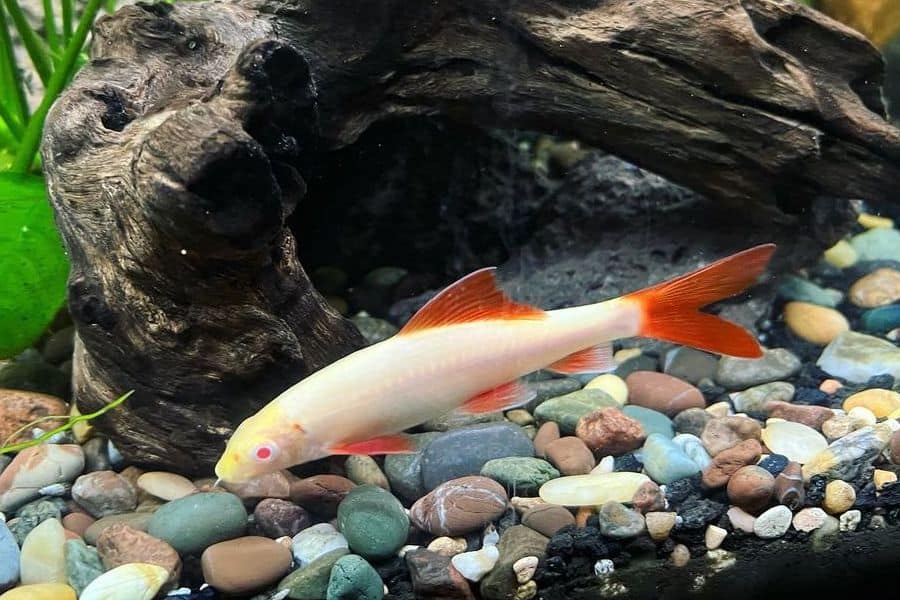
Rainbow shark’s color variant albino rainbow shark features a white or pale pink body, as opposed to the black body of a typical rainbow shark. They maintain the rainbow shark’s characteristic form, with a pointed snout and two frontal fins.
Their tail fins are red or pink in color, giving them the title “red-tailed” rainbow shark. Their eyes are pink or reddish in hue.
They have lateral lines along their bodies, which are sensory organs that enable rainbow sharks to pick up on vibrations and activity in the ocean. Additionally, they can be quite fast swimmers and have tiny, sharp fangs.
How Much Can a Rainbow Shark Grow in The Wild and In Captivity?
The length of a rainbow shark in the wild may reach 6 inches (15 cm), while they occasionally grow a little shorter. Many elements, like water temperature, the availability of food, and other environmental circumstances, could have an impact on the development rate of Rainbow sharks in the wild.
Though their development rate might be slower because of the tank’s more controlled environment, Rainbow sharks can also expand to a comparable size in captivity of 6 inches. The tank’s size and the owner’s level of care will both affect how big a Rainbow shark can grow while being kept in captivity.
Remember that rainbow sharks, like other fish, will enlarge to fit their surroundings. Giving the fish a tank that is the right size and can grow with them is therefore essential.
For one Rainbow shark, a tank should be at least 55 gallons in size. Larger tanks can be required for multiple species or to give more swimming area. Also, it is critical to refrain from overfeeding Rainbow sharks because doing so might affect their health and limit their lifespan.
In order for Rainbow sharks to grow to their full potential and live a healthy and happy life in captivity, it is important to provide them with balanced and varied food, as well as adequate water quality and an appropriate tank layout.
Rainbow Shark Diet and Nutrition
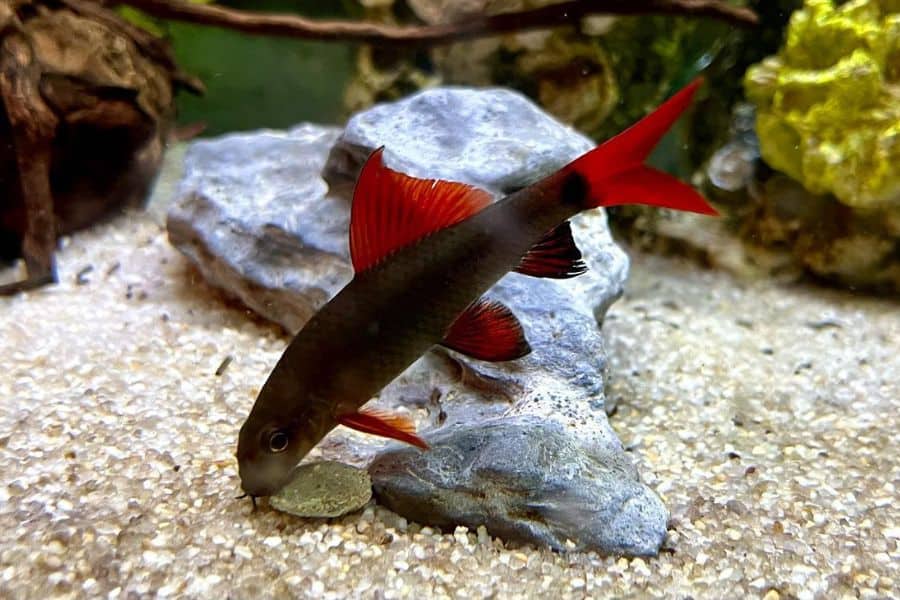
A rainbow shark’s diet will consist of both plant and animal stuff because they are an omnivorous species. They eat insects, tiny crustaceans, and plant materials in the wild.
It is critical to offer captive animals a nutritious diet that is both balanced and diverse. The mainstay of a Rainbow shark’s diet needs to be premium commercial fish food.
For Rainbow sharks, pellets or flakes made especially for bottom-dwelling fish or algae eaters are a suitable choice. Picking a fish meal that is full of protein and has a range of vitamins and minerals is crucial.
In addition to commercial fish food, Rainbow sharks also prefer live or frozen feeds including bloodworms, brine shrimp, daphnia, and tiny pieces of fish or shrimp. These foods will help give diversity and extra nutrients to the diet and can be offered as a supplement.
In order to prevent obesity and other health problems in Rainbow sharks, it is necessary to avoid overfeeding them. Feeding little portions twice a day and removing any uneaten food after a few minutes is a good general rule of thumb.
The well-being and health of Rainbow sharks depend on a proper diet. Owners may ensure their fish get the nutrition they need to develop and flourish by giving them a balanced and diverse diet.
Rainbow Shark Lifespan
In captivity, a Rainbow shark has a life expectancy of around 4-6 years. Some of them might survive up to 10 years or more with proper care and a healthy atmosphere.
The average life span of a Rainbow shark could be influenced by a number of factors, including genetics, diet, water quality, tank size, and overall health.
Providing a suitable tank size, a balanced and varied diet, and good water quality are all important factors in ensuring that a Rainbow shark lives a long and healthy life.
The fact that Rainbow sharks are susceptible to stress and health problems if their requirements are not fulfilled should also be noted. Stress and associated health problems can be brought on by crowded living conditions, unclean water, and a lack of safe hiding places.
The importance of providing Rainbow sharks with suitable and well-maintained habitats and frequently checking them for any signs of stress or illness cannot be overstated.
Overall, Rainbow sharks have a relatively short lifespan compared to some other fish species, but they can still make rewarding and enjoyable aquarium pets for their owners during their relatively short lives.
Rainbow Shark Temperament and Behavior
Rainbow sharks are known for their energetic and sometimes aggressive behavior, which can make them an interesting addition to a shared aquarium. They are generally territorial species and may become aggressive towards other bottom-dwelling or similarly shaped fish.
Due to this, it is better to keep Rainbow sharks with fish that are comparable in size or temperament. When first placed in a new tank, rainbow sharks can also be scared and wary. To help them adjust to their new environment, they may hide for the first few days.
Once they are comfortable, they will get more active and spend most of their time wandering at the bottom of the tank. Providing a suitable environment with plenty of hiding spots and shelter can help reduce stress and encourage natural behavior in Rainbow sharks.
They are also recognized as skilled swimmers and need a large swimming area to wander around freely.
Setting up A Rainbow Shark Tank
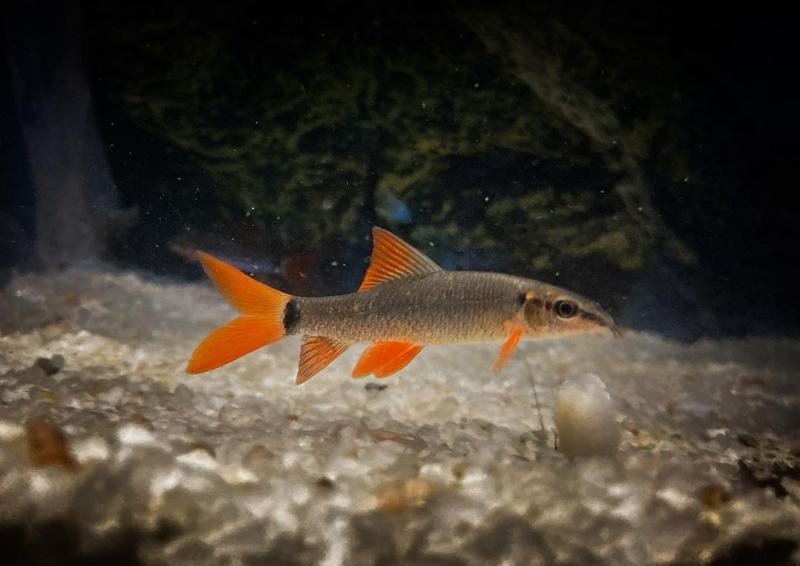
For the safety and well-being of Rainbow sharks, an appropriate aquarium habitat must be established. Below are a few suggestions to take into consideration:
1. Tank Size
For one Rainbow shark, a tank should be at least 55 gallons in size. Larger tanks might be required for numerous species or to give enough swimming room. It is crucial to provide the fish ample room to swim so they may move about freely and prevent crowding.
2. Water Temperature
Rainbow sharks enjoy water that is between 24 and 27 degrees Celsius). The fish might become stressed out by sudden temperature fluctuations; therefore, it’s crucial to keep the temperature steady.
3. Water Hardness and PH
Rainbow sharks prefer moderate water hardness levels of 5–11 dGH and a pH range of 6.5–7.5 which is slightly acidic to neutral. To keep the environment steady and favorable for the fish, it’s essential to test the water often and make modifications as necessary.
4. Décor
Rainbow sharks appreciate plenty of hiding places and shelter, as well as open swimming spaces. Decors such as rocks, driftwood, and caves can provide hiding places and shelter, while open spaces can be created with plants or by leaving some areas of the substrate clear.
5. Substrate
Rainbow sharks should be kept in a fine gravel or sand substrate because they are bottom-dwelling species and will spend a lot of time down there.
6. Plants
Rainbow sharks appreciate the presence of live or artificial plants in their tank. Live plants can help oxygenate the water and provide a natural environment for the fish. Anubias, Java Fern, Amazon Sword, Vallisneria, and Cryptocoryne are the best and safe for them.
7. Lights
To encourage plant growth and preserve the fish’s natural day/night cycle, you should provide light for at least 8 to 10 hours daily.
Rainbow Shark Ideal Tank Mates
It’s essential to take their temperament and behavior into account when selecting tank mates for a Rainbow shark. It is advisable to pick tank mates who are top or mid-level swimmers because rainbow sharks can be hostile and territorial towards other bottom-dwelling species.
These fish make good tankmates for rainbow sharks:
1. Gouramis
Gouramis may cohabit peacefully with Rainbow sharks. They may enhance the aquarium’s color and are mediocre swimmers.
2. Tetras
Small tetras, like neon tetras, can be suitable tank mates for Rainbow sharks. They are top-level swimmers and do not fight for the same space as Rainbow sharks.
3. Rasboras
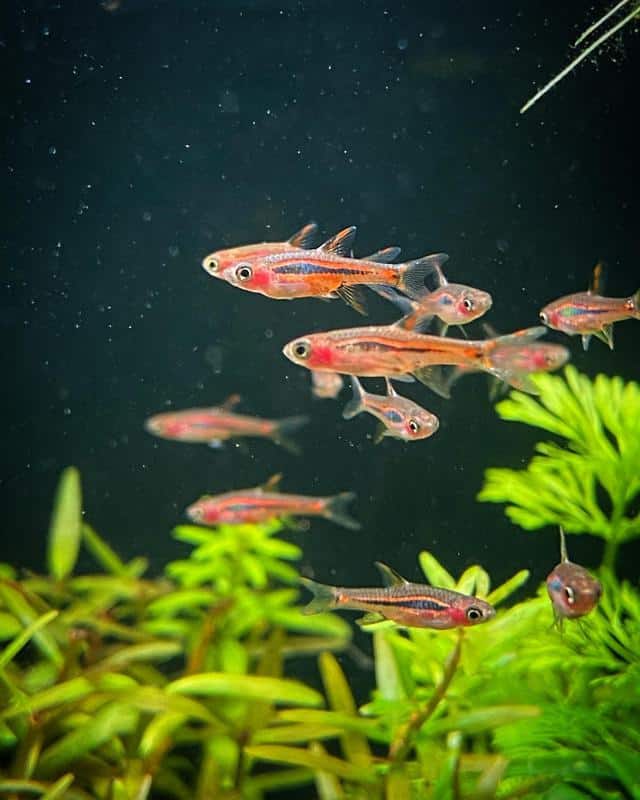
Rasboras are peaceful and can coexist with Rainbow sharks. They are mid-level swimmers and can add visual beauty to the aquarium.
4. Danios
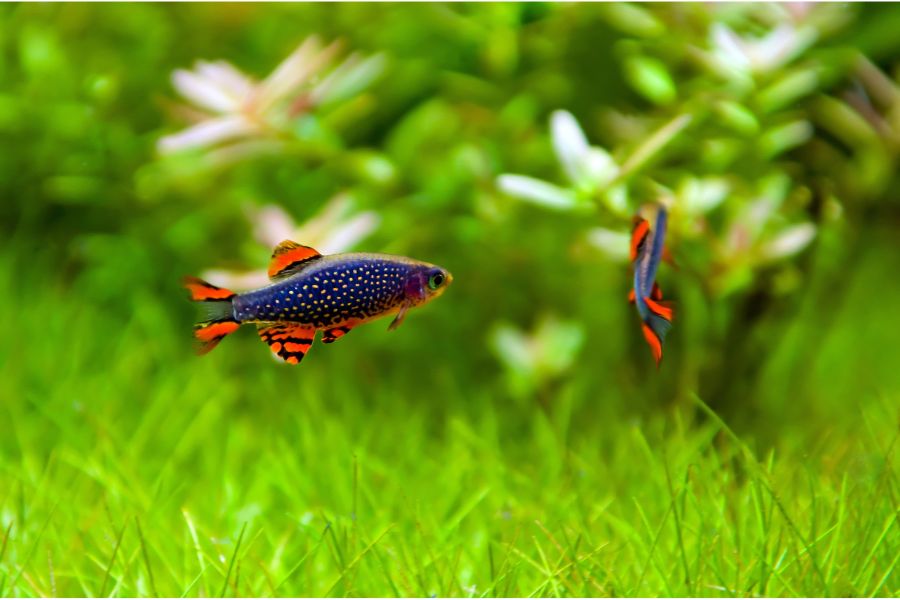
Danios are resilient, energetic fish that do well in community aquariums. They are expert swimmers and can give the aquarium more life and energy.
5. Plecos
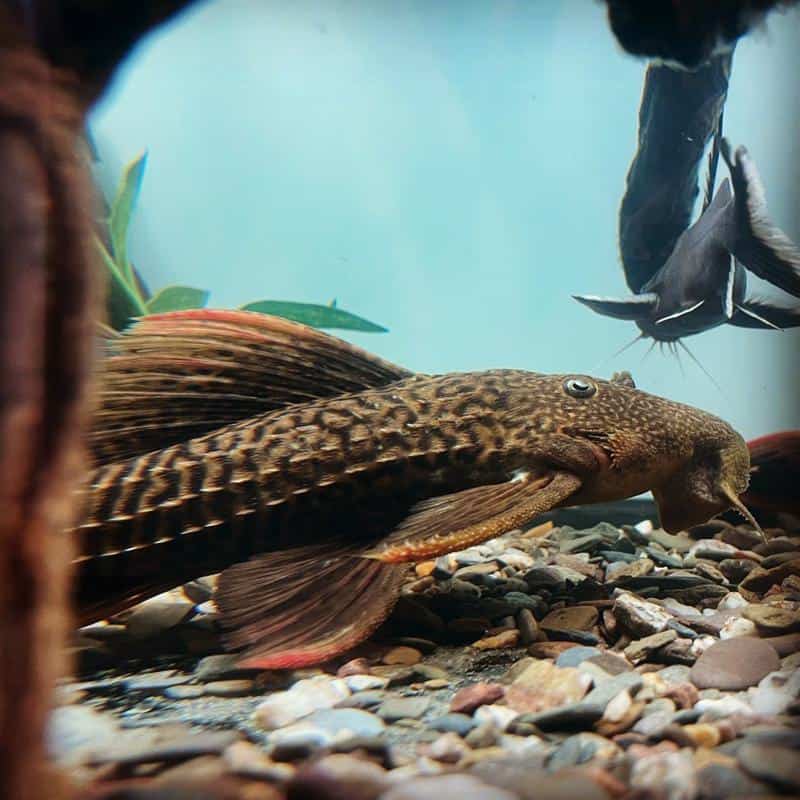
Rainbow sharks and bottom-dwelling Pleco fish may cohabit. They live harmoniously and do not fight over the same territory as Rainbow sharks. Moreover, by eating algae, they can contribute to the aquarium’s cleanliness.
6. Snails
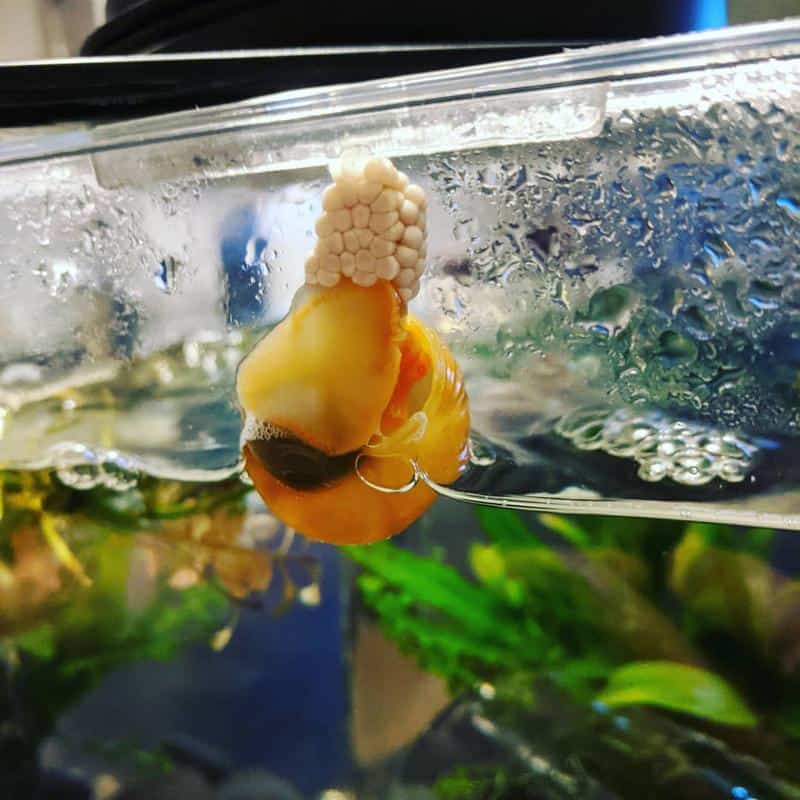
By eating algae and uneaten food, snails may also assist maintain the aquarium clean. Being bottom-dwellers, they do not contend with Rainbow sharks in the same area. Moreover, rainbow sharks never bother them or eat them due to their hard exterior.
Breeding and Fry Care
Their aggressive nature toward one another and potential danger to aquarium fish is the reason breeding Rainbow sharks in captivity can be difficult. But the following advice can help you if you want to breed Rainbow sharks:
- Provide the breeding pair with a roomy tank with lots of hiding spots.
- To mimic the breeding season, raise the water’s temperature a few degrees, and replace the water frequently to keep the quality high.
- Give the breeding couple a variety of premium meals, including live or frozen items like brine shrimp or bloodworms.
- Maintain a close eye out for behaviors indicative of pairing, such as chasing and biting, in the breeding couple.
- Remove the adult fish once the eggs are laid to stop them from devouring the eggs or fry.
- The eggs should hatch in a few days, and the fry will break the surface of the eggs in 5-7 days.
- Feed the fry small, frequent meals of live or frozen foods such as brine shrimp or crushed flakes.
- Keep the water clean and maintain good water quality to prevent disease and ensure the fry develops properly.
- As the fry grows, provide them with plenty of hiding places and gradually increase the size of their tank.
It is crucial to conduct thorough research and planning before attempting to breed Rainbow sharks since it may be a difficult and time-consuming procedure.
Common Health Issues in Rainbow Sharks
Although rainbow sharks are often resilient and simple to care for, they are still prone to some health problems like other fish. The following are a few prevalent health conditions that might harm rainbow sharks:
Fin Rot
A bacterial infection that can result in ragged and discolored fins is known as fin rot. Poor water quality or fin injuries may be the reason for this. The normal course of treatment is improving water quality, adding salt to aquariums, and applying a broad-spectrum antibiotic.
Ich
Ich is a common parasitic infection that can cause small white spots to appear on the fish’s body and fins. It is highly contagious and can be caused by poor water quality or stress.
Treatment usually involves raising the temperature of the water and using a medication specifically designed to treat Ich.
Velvet Disease
Velvet disease is another parasitic infection that can cause the fish’s skin to become covered in a velvet-like coating. It can be caused by poor water quality or stress. Treatment usually involves using a medication specifically designed to treat velvet disease.
Swim Bladder Disorder
Fish with swim bladder disorder may have trouble swimming, float upside down, or sink to the bottom of the tank. Overfeeding or bad water quality may be the cause of this. Enhancing the water’s quality and changing the fish’s food are typical treatment methods.
Stress and Aggression
If they are not given appropriate tank mates or if their habitat is not properly maintained, rainbow sharks may become agitated or violent. It may weaken the immune system and make them more vulnerable to illness.
It’s critical to give Rainbow sharks lots of hiding spots, compatible tank mates, and a clean environment in order to reduce stress and hostility.
Related:
- Roseline Sharks: Care, Diet & Tank Mates
- Freshwater Aquarium Shark Fish Types
- Chinese High Fin Banded Shark Care
FAQs
Can Rainbow Sharks Be Kept with Other Fish?
Certain fish, such as bigger, more tranquil species without a similar shape or color, could be housed with rainbow sharks. In order to reduce stress and aggression, it’s critical to offer lots of hiding spots and a hygienic atmosphere.
Do Rainbow Sharks Need a Heater in Their Tank?
Yes, Rainbow sharks require a heater to maintain a consistent water temperature within their preferred range of 74-79°F (23-26°C).
What Are Some Signs of Illness in Rainbow Sharks?
Loss of appetite, lethargy, fast breathing, or unusual behavior like hiding or swimming erratically is a few symptoms of illness in Rainbow sharks. Regularly check on your fish and get medical attention if any symptoms of an illness appear.
How Should a Rainbow Shark Be Introduced to A New Tank?
In order to reduce stress and shock, it’s crucial to adapt Rainbow sharks gradually to new tanks. It may be accomplished by either employing a drip acclimation approach or gradually introducing tiny volumes of water over the course of many hours from the new tank to its existing tank.
Throughout the acclimatization phase, it’s crucial to keep a watchful eye out for any symptoms of stress or disease in the fish.
How Often Should I Perform Water Changes in A Rainbow Shark Tank?
To keep the water in a Rainbow shark tank in excellent condition and prevent the accumulation of waste and toxins, it is advised to make a 20–25% water change once a week.
What Is the Difference Between Male and Female Rainbow Sharks?
The main difference between male and female rainbow sharks is that males tend to have more slender bodies and brighter colors, particularly in their fins. Whereas females are generally larger and rounder in shape with less vivid colors.
Additionally, mature males may develop small white spots on their heads and gill covers, which females do not typically have.
What Is the Difference Between a Rainbow Shark and A Red-Tail Shark?
Rainbow sharks and red-tail sharks are two different kinds of freshwater fish that come under the Cyprinidae family. Their external look is the primary difference between them.
Bright red-orange tail fins along with a few white patches are present on the rainbow shark’s dark-black body. However, red-tail sharks possess a black body, a brilliant red tail, and black fins.
Conclusion
A well-maintained habitat is necessary for the popular and alluring rainbow shark species to survive in captivity. When kept with appropriate tank mates, Rainbow sharks may bring a lot to a community tank, both in terms of their striking look and their distinctive behavior.
Their health and lifespan depend on proper feeding, good water, and tank design. Although maintaining Rainbow sharks can be difficult, the benefits of seeing these interesting animals grow and develop make the effort worthwhile.
A Rainbow shark can be a stunning and enduring addition to your aquatic family with the proper care.
